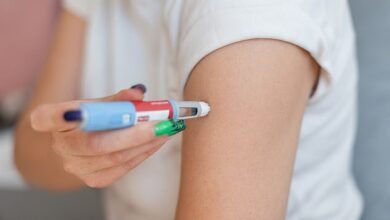Should you still take a Covid test if you have a runny nose?





Covid is on the rise. So for everyone’s safety, should we all be using Covid home test kits again when we get a runny nose, sore throat or cough?
Covid testing hit the headlines last week when British Olympic swimmer Adam Peaty announced he had tested positive, a day after winning silver in the 100m breaststroke.
Peaty said he made his test results public as a “champion of full transparency”.
Team GB said they were continually monitoring infection rates in Paris and the UK as cases rose in the weeks before the Olympics began. (There will be no regular Covid testing of athletes during the Games.)
Covid numbers are indeed rising in the UK, according to NHS data. This could potentially be due to the emergence of a new family of variants called FLiRT. The latest figures from the UK Health Security Agency (UKHSA) show that hospitals recorded 3,557 new cases in a week in mid-July, a 4.5 per cent increase on the previous week. There were also 152 deaths in a week, a 20 per cent increase.

Symptoms of Covid include fever or chills, cough, shortness of breath or difficulty breathing, fatigue, muscle or body aches, headache, loss of taste or smell, sore throat, stuffy or runny nose, nausea or vomiting, and diarrhea (file image)

Covid numbers are indeed rising in the UK, according to NHS data. This could possibly be due to the emergence of a new family of variants called FLiRT.
But that’s not the whole story, says Stephen Griffin, professor of cancer virology at the University of Leeds. “Official figures don’t tell the full picture because we’re not testing and reporting as rigorously as we used to,” he says. “Our only recorded tests now are on hospital patients. And those numbers are two weeks behind what’s happening.”
Latest figures from around four million users of the ZOE Health Study app show the UK had just under 100,000 symptomatic cases of Covid last week.
In response to rising numbers, many NHS sites are now requiring patients, visitors and staff to wear a face mask in clinical areas.
So who should get tested? The NHS is advising people at highest risk of Covid-19 to have a rapid lateral flow test as soon as they develop symptoms – although there is no official requirement. This includes people aged 85 or over; care home residents; and cancer patients.
But Dr Simon Clarke, senior lecturer in cellular microbiology at the University of Reading, says many more people should consider self-testing.
“There are no clear cutoffs for vulnerability, so other groups that should strongly consider testing are people with type 2 diabetes or who are morbidly obese. But I don’t think people should be forced to test.”
If you have symptoms, the precautions to stop the spread apply, whether it’s Covid, a cold or the flu, he says. That means not only staying away from vulnerable people, but also “the courtesy of taking steps to stop the spread: the old flu advice – catch it, throw it away, kill it – applies very much to Covid as well.”
Professor Griffin goes one step further and says that if you have symptoms similar to Covid (currently runny nose, headache, cough, sore throat and muscle aches are the most common) ‘you can buy a Covid test kit and then use that’.
He warns: ‘A negative test doesn’t necessarily mean you don’t have Covid – it can miss the virus in up to 30 per cent of cases.’ Instead, repeat the test as instructed. As for going to work or socialising, the current NHS advice is that if you test positive, you should ‘try to stay away from other people until you feel better’.

Adam Peaty tested positive a day after winning silver in the 100m breaststroke at the Paris Olympics

It also says: ‘If you have to go out, avoid indoor or crowded places (including public transport or large social gatherings) or places where there is not much fresh air.’
The Advisory, Conciliation and Arbitration Service (Acas) says: ‘If you test positive for Covid, you must tell your employer. Self-isolation is no longer a legal requirement. Instead, you must follow your employer’s policy.’
Professor Griffin is more cautious: ‘If you can, stay home. Don’t go back to work too quickly, because if you do things too quickly, you run a higher risk of getting long-Covid.’
What about masks? If you are infected, the current NHS advice is to ‘wear a face covering if it is difficult to keep away from other people’.
A new scientific analysis from the University of Oxford finds that any type of mask is better than no mask.
If you decide to get tested, you can still buy it cheaply at pharmacies and online.
‘It is best to use a test kit that has not yet expired,’ says Professor Griffin. ‘If you only have one that has been sitting in a drawer for a while and is past its expiry date, but the fluid in the [plastic tube that the swab goes into] “If it hasn’t evaporated, then it’s fine as a last resort.”




